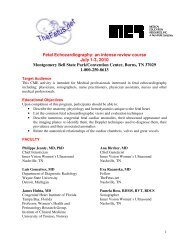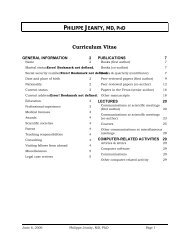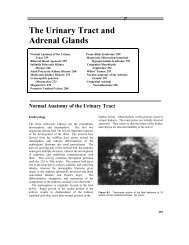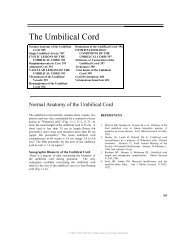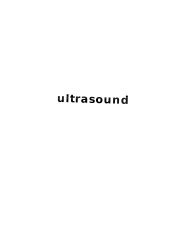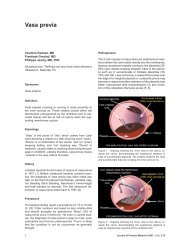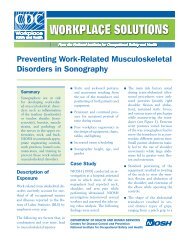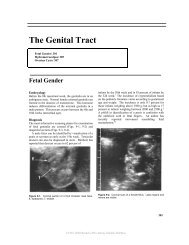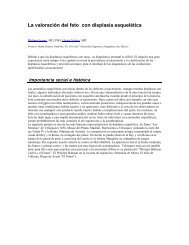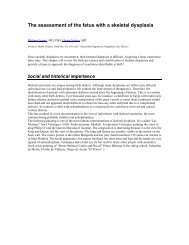Conjoined Twins: Developmental Malformations and ... - SonoWorld
Conjoined Twins: Developmental Malformations and ... - SonoWorld
Conjoined Twins: Developmental Malformations and ... - SonoWorld
Create successful ePaper yourself
Turn your PDF publications into a flip-book with our unique Google optimized e-Paper software.
<strong>Conjoined</strong> <strong>Twins</strong>: <strong>Developmental</strong> <strong>Malformations</strong> <strong>and</strong> Clinical Implications<br />
somewhat fuzzy. Though it appears impressive, it conceivably could be misleading. "Janiform"<br />
cephalothoracopagus twins, connected ventrally from umbilicus to vertex with two composite faces<br />
oriented in opposite directions, might yield a similar appearance if the orientation of the radiograph was<br />
perpendicular to the midfacial axis, with the two spinal columns partially superimposed, <strong>and</strong> each pelvis<br />
was rotated approximately 90 degrees to face the same direction as one of the faces.<br />
A few bizarre cases reported in Table 9-1 <strong>and</strong> in a 1996 article by Spencer et al. [9] are offered as<br />
possible examples of rachipagus twinning, but none provides convincing proof of her interpretation.<br />
Taruffi's monumental review of the world literature up to the early 1880's [10] disclosed no anatomically<br />
confirmed case similar to that depicted in the French radiological paper, <strong>and</strong> a Medline search reveals no<br />
recent reports of similar cases. Furthermore, I have not found a convincing description of this type of<br />
twinning in another vertebrate species. Before adding the rachipagus pattern to the list of established<br />
patterns of conjoined twins, I would like to see more anatomical evidence than the aforementioned single<br />
radiograph.<br />
The designation of rachipagus is not my only concern about the classification scheme <strong>and</strong> nomenclature<br />
proposed by Dr. Spencer, which is based primarily upon her embryological theory. It adds new areas of<br />
confusion <strong>and</strong> controversy without resolving old ones. Simplification is achieved by lumping the most<br />
difficult <strong>and</strong> controversial patterns of twinning together into a single "atypical" category. Novel words<br />
are introduced <strong>and</strong> older terms are given new meanings. While insisting upon precision in the application<br />
of some terms, she is imprecise in others. For example, "omphalopagus" has long been used for ventral<br />
supraumbilical conjunction confined to the umbilicus or cord, but Dr. Spencer extends the use of this<br />
term to all cases in the thoracopagus series with separate hearts, regardless of the degree of thoracic<br />
conjunction. Cardiac anatomy is so dominant a consideration in the surgical evaluation of conjoined<br />
twins that there is no obvious need to incorporate it into the name of the twinning pattern at the cost of<br />
anatomical precision.<br />
Creation of the "parapagus" category is, in my view, a particularly unfortunate one. This designation is<br />
proposed for a spectrum of patterns traditionally viewed as axial duplications, most often observed in the<br />
anterior (or rostral) end of the axis. The "parapagus" designation reflects Spencer's fusion theory, which<br />
seems unlikely to achieve wide acceptance. Existing designations for rostral <strong>and</strong> caudal axial<br />
duplications accurately describe the anatomy of this pattern, <strong>and</strong> are consistent with the findings of<br />
experimental <strong>and</strong> descriptive embryology.<br />
Without belaboring all my reservations about this classification scheme, I will simply offer the opinion<br />
that problems involving conjoined twins are not likely to be resolved by new taxonomies. In the<br />
molecular era, new paradigms might lead to entirely different ways of thinking about twinning, but until<br />
then I plan to muddle along with the familiar imperfections of existing terminologies rather than<br />
accepting this new one.<br />
My affection <strong>and</strong> respect for the author, with whom I have enjoyed a cordial correspondence for many<br />
years, makes it especially painful to express so many negative comments about a book that represents so<br />
http://link.springer-ny.com/link/service/joumals/10024/contents/03/4038/paper/body.html (4 of 5) [9/9/2003 11:23:52 AM]



